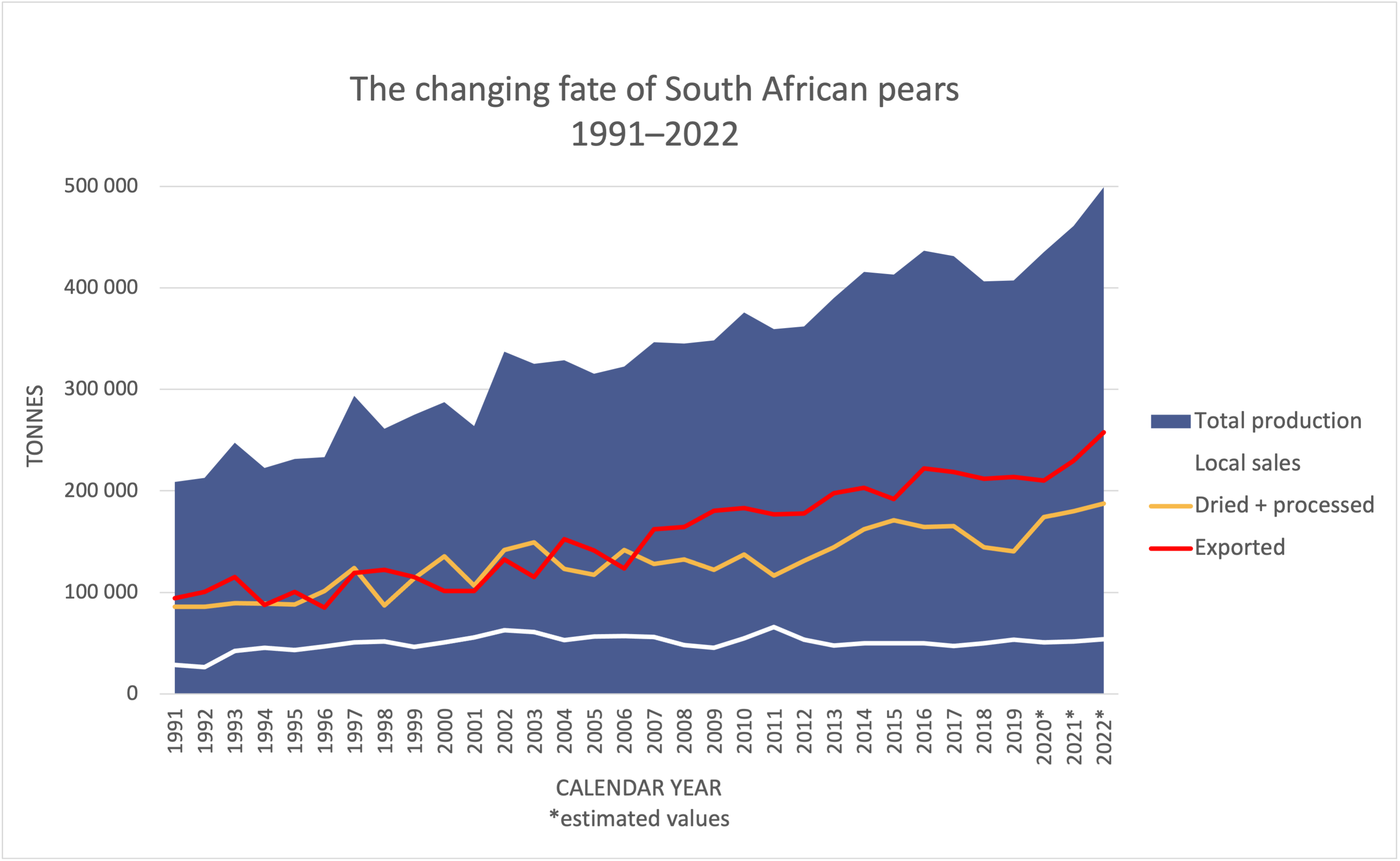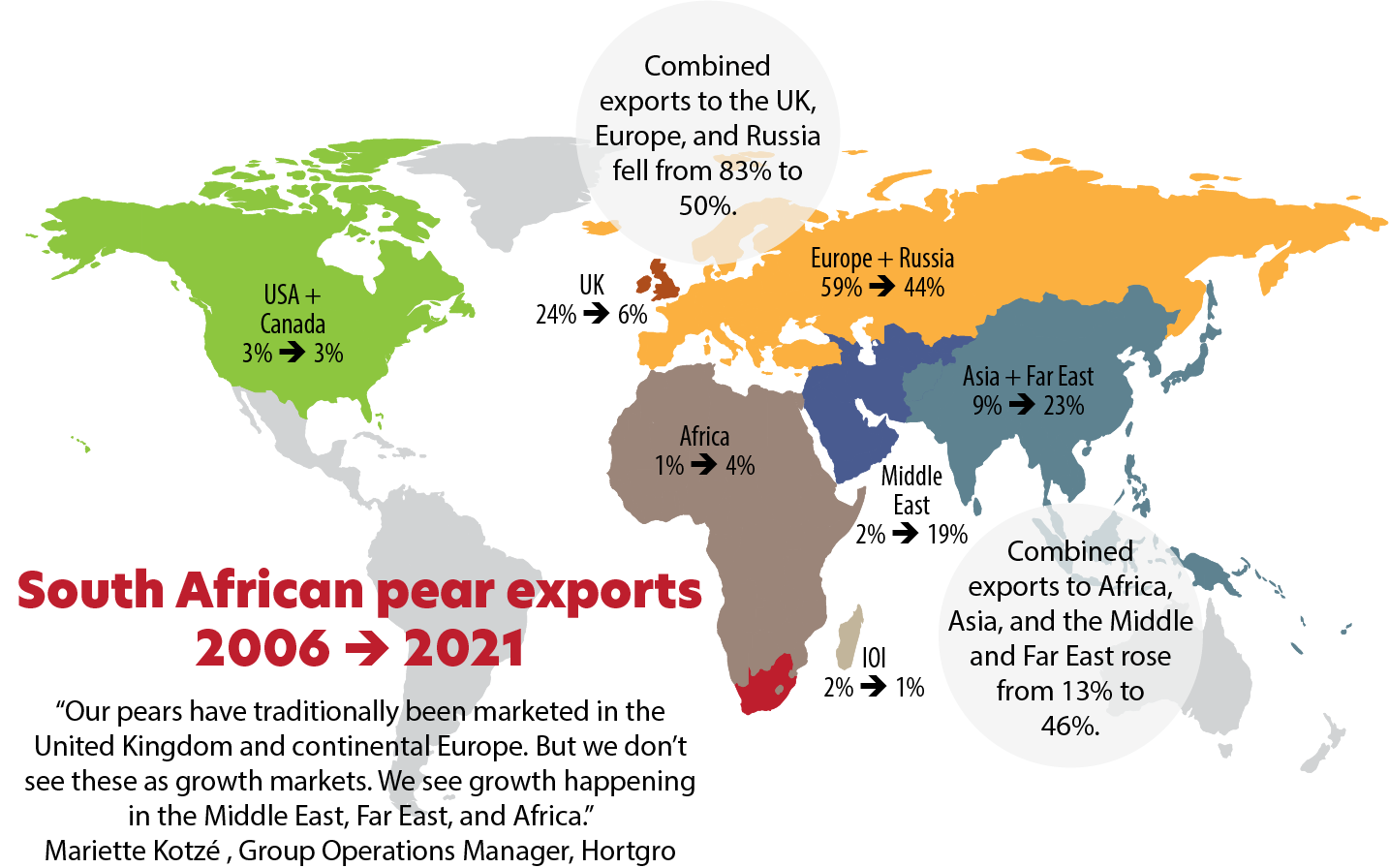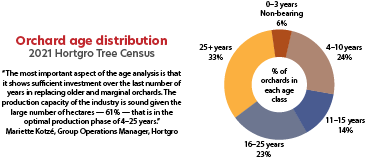During this time, local sales of fresh pears have remained fairly stable at around 50 000 tonnes per year. The additional tonnes have been dried, processed, or exported fresh.
Figure 1 shows that the amount of fruit exported fresh was similar to the amount processed and dried until 2006–2007. Fresh exports have been ahead ever since, taking up roughly half of our pears.

The United Kingdom, continental Europe, and Russia remain important markets, but a look at Figure 2 will show that the growth is in other regions.
This trend is likely to continue, as global fruit consumers are increasingly to be found outside Europe and North America.
Populations in Africa and Asia are becoming more urbanised and higher earning. City dwellers buy food, and people with more income buy fruit.
There are likely to be about 500 million more potential fruit consumers in Africa, and 2.3 billion more in Asia, by 2040 than there were in 2017.

Two recent developments bode well for South African pear exports. One was gaining market access to China in late 2021 — 18 years after starting the application process.
The first trial shipment of Forelle and Packham’s Triumph reached China in September 2022.
The second was the approval by India of in-transit cold treatment for South African apples and pears.
In-transit cold treatment reduces the time fruit takes to reach the consumer, which translates into better quality and freshness.
Where are we growing pears?
Ceres is the largest pear-production area, with 4 734 hectares. Elgin-Grabouw-Vyeboom-Villiersdorp is in second place, with 3 034 hectares, followed by the Langkloof and Wolseley-Tulbagh.
Although pears are also grown in other regions, all have less than 1 000 hectares planted to pears, and their combined contribution to the total area is only 12%.
The total area planted to pears has changed little in recent years — it was 12 279 hectares in 2016 and 12 743 in 2021.

The top three South African cultivars
Packham’s Triumph
An Australian farmer called Charles Henry Packham transformed the South African pear industry when he decided to cross Uvedale’s St Germain and Williams’ Bon Chrétien in the 1890s.
His second batch of seedlings yielded what is now known as Packham’s Triumph.
Ripening later than Williams’ Bon Chrétien, Packham’s Triumph became popular in warmer pear-growing areas.
The Transvaal Department of Agriculture imported it to South Africa in 1904.
A 1972 publication by the Research Institute for Fruit and Food Technology — now the ARC Infruitec-Nietvoorbij —
describes Packham’s Triumph as the only cultivar with all the desired characteristics: wide market acceptance, large size, and good storage and shelf life.
The authors note that it is our main export pear.
This remains true fifty years later. About 44% of South African pear exports in 2021 were Packham’s Triumph and it represents about a third of hectares planted.
Forelle
Forelle is a German variety thought to have originated in northern Saxony in the early 1700s. The name is German for trout and refers to the speckled appearance of these pears.
The German pomologist Adrian Diel sent it to Jean-Baptiste van Mons in Belgium. Van Mons was a polymath with a passion for breeding fruit.
He sent Forelle to the Horticultural Society of London from where it reached America.
It is not known who first imported Forelle to South Africa. The colourful cultivar was widely grown in the United States from where it may well have been brought by Harry Pickstone.
He records the export standard for it in his 1915 book Hints for Fruit Growing.
Forelle was initially difficult to export due to mealiness.
The development of appropriate post-harvest practices led to an upsurge in Forelle growing and it accounted for 28% of pear exports —
18% Forelle and 9% Vermont Beauty (green Forelle fruit) — and 28% of hectares under pears in South Africa in 2021.
Williams’ Bon Chrétien
Williams’ Bon Chrétien was a self-sown tree found in an English garden in 1770. Nurseryman Richard Williams acquired material of the cultivar for propagation.
Williams exhibited its fruit before the Horticultural Society of London in 1816. They were so impressed that they named the pear Williams’ Bon Chrétien in reference to the prestigious Bon Chrétien d’Hiver pear.
Bon Chrétien was recognised as a type of pear as far back as the 1500s and many cultivars carry this name.
One story goes that the French King Louis XI named the original Bon Chrétien d’Hiver pears after St Martin of Tours — the good Christian who brought the pears along when attending Louis on his sickbed.
Williams’ Bon Chrétien is called Bartlett in the United States.
Pickstone writes in 1915 that Williams’ Bon Chrétien is an old variety that has been in South Africa for many years.
He considers it the best pear for drying. He also recommends picking it before it shows colour to prevent excessive ripening during cold storage and export.
Williams’ Bon Chrétien was the third-biggest pear cultivar in South Africa in 2021 by area planted — 17% of the total — and cartons exported — 9%.
But this old favourite is becoming less important with new planting in decline and more than half our Williams’ Bon Chrétien orchards more than 25 years old.












